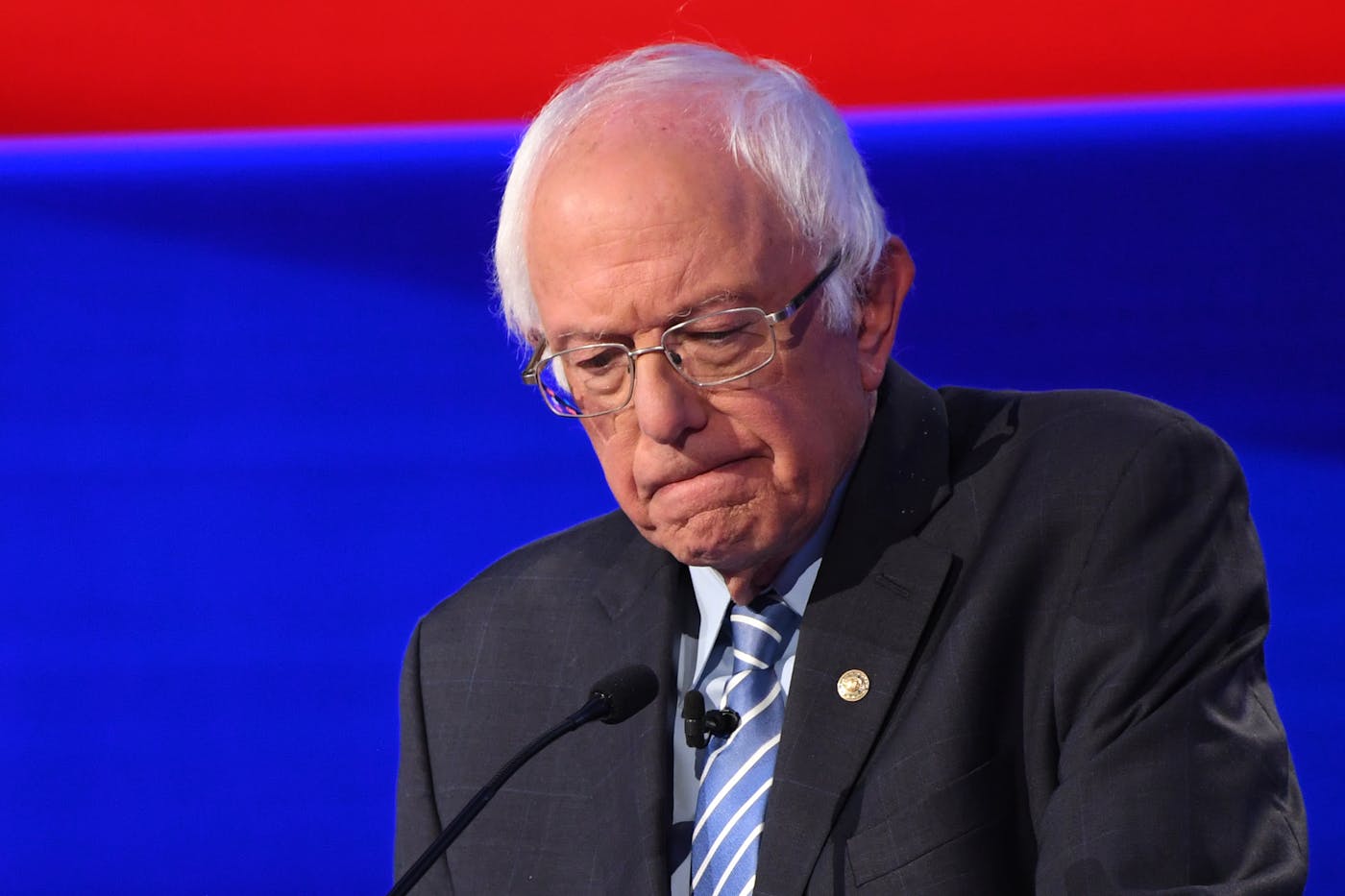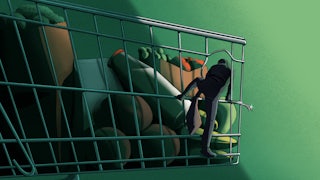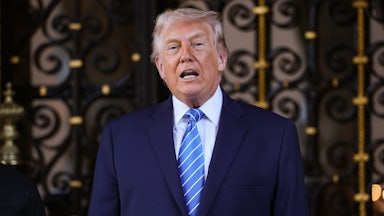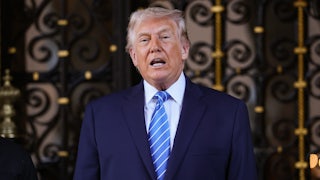Bernie Sanders arrived in Ann Arbor in late winter, his future to be decided in two days. Thousands of students thronged the University of Michigan campus, gripping their blue-and-white signs, one so overcome with emotion she battled back tears as Sanders spoke. Above a sea of expectant faces, his name was spelled out in enormous, yellow block letters: B.E.R.N.I.E. The students held them high and wouldn’t let go.
Few could pack a house like Sanders, who was thundering through a second campaign that was supposed to lead him, finally, to the White House. If Michigan was going to be his last stand, it was as good a place as any to be, to feel, once more, a mass of bodies stretching toward him. Alexandria Ocasio-Cortez urged the students to bring five friends each to the polls.
Sanders told them, quite simply, that he was going to win.
“We’re taking on Wall Street. We’re taking on the insurance companies. We’re taking on the drug companies. We’re taking on the fossil fuel industry,” the senator declared. “We’re taking on the military-industrial complex. We’re taking on the prison-industrial complex.”
As the warmth of the afternoon bled into an evening chill, the college students, and Sanders himself, could believe it was all still possible: free health care, free college, an end to fossil fuels through a far-reaching Green New Deal. All he had to do, in that wintry stretch of March 2020, on the eve of the most deadly pandemic in U.S. history, was triumph again in the erstwhile hub of labor power in America. He could catapult himself, after a rough Super Tuesday against Joe Biden, into a brilliant spring. He could march, heroically, into the Democratic convention.
“Michigan is the most important state coming up on Tuesday,” Sanders said.
The Wolverine State had been a vital proving ground in 2016, where Sanders managed a shocking upset over Hillary Clinton and regained enough momentum to be a force at the turbulent convention that summer. Sanders, a tireless defender of organized labor and a fierce critic of free-trade agreements, had found a receptive audience in the deindustrialized state, particularly with the disaffected white, working-class voters who, he warned, were drifting out of the Democratic Party. After Donald Trump had blasted open Clinton’s blue wall and swept Michigan, Wisconsin, and Pennsylvania, Sanders could no longer be dismissed as a relic or a gadfly. Instead, he was the prescient leftist who diagnosed the Democratic establishment’s chronic myopia.
Four years later, Sanders was facing down Biden in a state where he had bested Clinton in 73 of 83 counties. A redux could still be in the offing.
Instead, on March 10, Biden swept every single county. The Sanders campaign, held to less than 40 percent of the vote, was effectively over. It was, in the fraught tale of democratic socialism in the United States, a deeply dispiriting chapter for the many leftists who dreamed of so much more. The mainstream breakthrough of socialism on the national stage, which seemed so possible in 2019 and 2020, had not come to pass. Three years later, it’s not clear whether it ever will. If positive views of capitalism have slipped since 2019, some evidence suggests perceptions of socialism have, too.
It would be crude to reduce the state of socialism in the United States to the performance of two presidential campaigns. Or to assess its present condition at all without accounting for what came before: decades and decades of absolute futility. In 2023, socialism is still, relative to even a decade ago, enjoying a remarkable resurgence. There are close to 160 Democratic Socialists of America–backed politicians in elected office nationwide. The organization itself, which embodies socialism as much as any in this country, boasts just over 80,000 members; before Sanders’s first presidential campaign, there were barely 6,000. DSA lawmakers include Ocasio-Cortez, perhaps the most famous member of Congress, and a host of influential local legislators. There are now functioning and growing socialist caucuses in the Minnesota state legislature, the Los Angeles municipal government, and the New York state legislature, where socialists successfully pressured the centrist governor to permit the state to build and own renewable energy infrastructure. Brandon Johnson, the new mayor of Chicago—a city with a long tradition of conservative Democratic governance—is not a member of DSA, but he was enthusiastically supported by the rank and file of Chicago’s socialists.
Sanders himself, who turns 82 in September, finished a two-year stint chairing the Senate’s influential Budget Committee and now heads up the Health, Education, Labor, and Pensions Committee. It’s a powerful perch from which he was able to excoriate Howard Schultz, the longtime Starbucks CEO, over his hostility to labor unions. If Sanders has failed to bring single-payer health care to the United States or make public colleges tuition free, he has forced a reorientation of the Democratic Party away from the neoliberalism of the Carter and Clinton and even Obama years to its current labor-friendly, welfare state–embracing posture. It is difficult to imagine Biden canceling a major chunk of student loan debt—as he attempted to do, only to be blocked by the Supreme Court—without two successive Sanders presidential campaigns. The renewed embrace of the Franklin Roosevelt legacy, as found in Biden’s green industrial policy, can be traced in no small part to Sanders winning tens of millions of votes. Last year, Biden and the Democratic-controlled Congress invested over $300 billion in climate provisions, more than any other sitting government in U.S. history.
The post-2016 explosion of DSA, the rise of AOC, and the dramatic increase of proudly left-wing House members stem in part from Sanders’s influence. Ocasio-Cortez herself had been a volunteer on the 2016 campaign. At the same time, DSA has managed to work in concert with other influential leftist organizations that are not socialist, like the Working Families Party and Justice Democrats, to help increase the number of socialists in elected office.
Yet the socialist story in the United States, as is true of most movements, is no longer one of relentless ascent. A few years after the onset of the pandemic—with an elevated crime rate in many cities; lingering inflation; the dissipation of anti-Trump zeal, even with the man himself running again—DSA has actually shed backers. Kicking off in 2020, a recruitment drive aimed at boosting membership to 100,000 never reached its goal, and that target is no longer touted so publicly. More broadly, socialist and socialist-friendly politicians have faced roadblocks on the local and federal levels, running into resistance from entrenched Democratic institutions, donors, and, yes, voters. Perhaps most important: Sanders was never elected president, and the larger left is bereft of any prominent or scandal-free standard-bearer as Biden seeks to again claim the Democratic nomination. Marianne Williamson, an author and self-identified progressive, is running again after polling poorly in the 2020 race and dropping out. Robert F. Kennedy Jr., the environmentalist and vaccine skeptic, is attempting the libertarian-populist lane against Biden, though his alliance with Steve Bannon and other far-right figures will limit his appeal to the Democratic electorate. Sanders himself, in a nod to the changing mood, has already endorsed Biden.
The Vermont senator’s dream of a united and unstoppable mass coalition of working-class voters has yet to materialize. A socialist—or even a run-of-the-mill progressive—vote remains rooted, for the most part, with the college-educated, though gains have been made elsewhere. Establishment Democrats are far more on guard than they used to be, fundraising heavily and campaigning aggressively to ensure they don’t suffer the fate of Joe Crowley, the Democratic congressman and party boss AOC felled to claim her seat.
Crucially, working-class Democrats and independents remain, on cultural and public safety questions, more moderate than many leftists would like. Black Democrats in Philadelphia chose as their next mayor a woman who wants to reinstate a version of stop-and-frisk and hire more police. Some Latino voters with family history in countries like Cuba and Venezuela continue to be wary of any socialist. In New York, Eric Adams, a corporate-friendly Democrat popular in the African American and Afro Caribbean neighborhoods of the outer boroughs, has made resentment of socialism a cornerstone of his mayoralty. “You water the tree of freedom with your blood,” he said in a Memorial Day speech. “We sit under the shade of that tree of freedom protected from the hot rays of socialism and communism and destruction that’s playing out across the globe.”

Just as vexing, for those who long for a true Sanders successor, is that even some of the most left-wing members of Congress would rather not identify as socialist at all. Sanders famously kept a portrait of Eugene Debs, the legendary socialist leader, in his office. His chosen successor in Vermont, a former schoolteacher who proudly ran and won with his backing last year, won’t say the S-word.
“I don’t think it matters for my constituents here,” Becca Balint, Vermont’s new at-large congresswoman, told me. “As somebody who has been kind of shackled to a label my whole life as a queer person, I don’t have a whole lot of interest in other people defining me. I always say, if people want to know who I am, I’m a scrappy little dyke.”
Balint is newly arrived to Congress, but Ro Khanna, who co-chaired Sanders’s 2020 campaign, is not. A Silicon Valley Democrat, Khanna has been touring the country over the last year touting his version of “economic patriotism,” a proposed New Deal–style investment in distressed communities that would make Sanders proud. He is not running for president in 2024, but it’s plausible he’ll be a contender in the future—one possible heir to the Sanders legacy.
There’s one catch: Khanna is, very explicitly, not a socialist. In fact, he joined a Republican consensus and a large share of moderate Democrats in voting for a House resolution that directly condemned socialism earlier this year. (The “Squad” of young, leftist Democrats who were elected starting in 2018—AOC most prominent among them—voted against it.) Khanna wanted to make clear that, for all the ways he admired Sanders, there would be no ambiguity over how he views American capitalism.
He’s completely for it.
“I am an FDR Democrat. I believe that we can empower the working class, bring new factories to small towns, [and] create economic opportunity for Black and brown communities with a free enterprise system that rewards work,” Khanna told me. “There is not a tension between innovation, entrepreneurship, technology, production, and improving life for working families.”
It can sometimes feel as if the reluctance to embrace the term extends even to those whose reputations are inextricably bound to it. Earlier in the year, Ocasio-Cortez produced a video for Instagram answering a question often posed to her and her allies: “How do you respond when people accuse you of being a ‘socialist’?”
Speaking in a whisper—AOC was imitating the popular online ASMR videos, which may cause the viewer to relax, be comforted, or even fall asleep—the congresswoman argued that “most people” don’t know what capitalism or socialism is and that they aren’t capitalists, in part because they lack “capitalist money” and aren’t billionaires.
“The label doesn’t matter as much as just talking about policies. That’s easier to understand,” she continued. “Do you think people should die because they can’t afford insulin? Do you think that fossil fuel CEOs should decide whether the planet gets set on fire? Me neither.”
“Unionize your workplace. Start a worker cooperative. If it’s too extreme for working people to own the means of production, why is it OK for private billionaires to own the means of production?”
Though she embraced tenets of socialism—worker-owned companies, strong labor unions, opposition to for-profit health care—it was notable that Ocasio-Cortez nevertheless declined to identify as a socialist to her millions of followers. She also seemed to skirt over the fact that many American socialists would consider millionaires, as well as those earning well into the six-figure range, too wealthy. An investment banker raking in $350,000 or a corporate attorney making somewhere shy of $1 million is not typically any friend of the American socialist—yet they may, in Ocasio-Cortez’s formulation, be exempt from opprobrium.
Lauren Hitt, a spokesperson for Ocasio-Cortez, insisted the congresswoman still identifies as a democratic socialist. She said the video was designed as a guide for interacting with those who are hostile to the concept of socialism though open to the policies themselves.
But what, in 2023, distinguishes a socialist from a progressive or left-leaning Democrat? What will keep socialists, who already campaign in Democratic primaries, from being swallowed whole into the party, co-opted, and eventually marginalized? These are questions the most dedicated socialists are grappling with today, as they pass, perhaps, their high-water cultural mark—friendly organs like the podcast Chapo Trap House and magazine Jacobin are no longer fresh upstarts, and they have very large followings—and settle into a new middle age, defending their gains and straining, somehow, to become power brokers at the national level who might fundamentally reorder American capitalism for a socialist future.
There are two functioning, active vehicles for socialism in the United States: DSA and Socialist Alternative. DSA is far larger (SA boasts about 1,000 members nationally) and has many more of its own in elected office. DSA members, in virtually every instance, campaign in Democratic primaries. (Five years ago, I ran myself in a Democratic primary for state Senate in New York, and tried and failed to secure DSA backing.) Socialist Alternative, meanwhile, has a more radical prerogative: build a socialist, worker-based third party to oppose Republicans and Democrats alike as soon as possible. Many members of DSA, an organization with a diffuse leadership structure and a multitiered endorsement process that empowers local chapters over a centralized executive, want a third party, too, but will make accommodations for the American duopoly. SA won’t.
Kshama Sawant, a Seattle City Council member who has drawn headlines for the better part of a decade for her furious opposition to Amazon, and who touts giving away, each year, a large portion of her six-figure salary, is SA’s lone elected member. She takes a dim view of DSA’s electoral strategy.
“After a meteoric rise in the membership of DSA nationally, you’re seeing an organization in utter crisis,” Sawant argued. The Seattle council member is among a cohort of socialists who lament that Sanders never ran a third-party campaign or attempted to build out such a party after he lost to Clinton in 2016. A vocal faction, especially online, lambasted Squad Democrats in the House for failing to force a vote in early 2021 on Medicare for All, Sanders’s prized single-payer health care plan, by withholding support for Nancy Pelosi’s speakership.
In response to Sawant, Chris Kutalik, a DSA spokesperson, said the group remains “light years ahead” of where it was in its “takeoff period” between 2016 and 2021. “Even with setbacks, we still have wind in our sails. We are still the largest socialist organization since the 1930s, with chapters in all 50 states,” he added, estimating that DSA currently has close to 160 elected officials at all levels of government, and insisting “that number continues to grow with each cycle.”
Socialists in both organizations grapple with the question of how to hold their own accountable. For now, SA, with one elected official, can only confront this challenge in a mostly theoretical sense; in fact, Sawant announced earlier this year that she wasn’t seeking reelection. But rank-and-file democratic socialists have found themselves at odds, at times, with the politicians they helped elect. There’s the Brooklyn state senator who co-sponsored a bill to aid public housing that some socialists believe is a back door to privatizing the housing stock. There’s the Chicago alderman who faced censure from the local DSA chapter for supporting a municipal budget that it argued did not sufficiently cut police funding. And there’s the Boston DSA chapter that considered expelling a state representative for a variety of offenses, including supporting a “milquetoast” stabilized-rent program and endorsing a non-DSA candidate in a contentious race; he dropped his affiliation before facing discipline.
If a DSA-endorsed politician is also a Democrat in a Democratic caucus, whom do they answer to first? DSA or a Democratic majority leader? For Sawant, the answer is clear enough. “The Democratic Party is not the place for the working class to win any victories or build anything long-lasting,” she said. “It’s proven to be a dead end. The majority of DSA leadership continues to go down that road.”
All socialists—whatever their affiliation—long for the birth of a socialist United States. The most left-wing Democratic Party in at least 40 years is already here. But is that as much as anyone can hope for?
What is a socialist, anyway? And why is a mainstream, center-left American political party now harboring a far larger number of them than it did 10, 20, or 50 years ago? In the early decades of the last century, it would have been unimaginable for a self-identified socialist to compete as a Democrat. For one, Democrats and Republicans were sometimes viewed, almost equally, as tools of the capitalist class, where industrialists and big city bankers found their willing foot soldiers. Liberals and reformers existed in both parties, but so did overriding hostility to communism and its socialist offshoots, both of which rapidly gained popularity at the tail end of the nineteenth century.
Eugene Debs, a gifted orator and militant labor leader, won renown for standing up to the exploitative railroad companies of the Gilded Age. He viewed labor struggle as a war between classes—the factory owner and the employee—and advocated for public ownership of the means of production, whether they be factories, mines, or railroads. Debs was never a strict theorist, and his socialism, which would electrify the Socialist Party of America that he founded in 1901, owed as much to Walt Whitman and Protestantism as it did to Karl Marx. He called socialism “Christianity in action” for simply recognizing the “equality in men.” Unlike many labor leaders of his era, Debs argued for the admission of Black people and women into his railway union, and cared more about racial uplift than other white socialists.
The Socialist Party was for women’s suffrage, public ownership of trusts, minimum-wage laws, the abolition of child labor, and the eight-hour workday. In large cities and rural counties alike, the new party found immediate popularity, with Debs as its national standard-bearer. By 1911, the party had elected, by a conservative estimate, 1,141 Socialists to local office in 36 states. They controlled cities as large as Milwaukee and Berkeley, and elected two members of Congress. Debs ran for president as a Socialist five times, winning as much as 6 percent of the popular vote in 1912. (In 2000, Ralph Nader won less than 3 percent on the Green Party line.)
But the Socialist Party could rise only so far against the Republican-Democratic duopoly. Then, as now, there was no European-style Parliament with proportional representation to incubate third parties. In keeping with Duverger’s Law, a single-member district, winner-take-all electoral system was always going to punish organizations that operated outside the mainstream and shrink the number of viable political parties. Democratic and Republican political machines dominated most local governments, and Socialist candidates found themselves having to compete against the combined might of two larger parties that wanted them to go extinct.
Still, in 1920, five socialists entered the New York state legislature. They were in their late twenties and early thirties, and all of them took office in the wake of the Palmer raids and the first Red Scare. The speaker of the New York state Assembly, a Republican, called the socialist lawmakers “un-American” traitors “allied with the forces of Soviet Russia in an attempt to institute in this country a new form of government and a dictatorship of the proletariat.”
In a matter of months, the Assembly would vote to expel all five socialists. “The real reason we Socialists were unseated,” Samuel Orr, one of the assemblymen, argued, “was not because we made disloyal remarks or committed disloyal acts, but because we had agreed to put through bills that would reduce the price of milk and frustrate the transit corporations from boosting the rate of fares.”
“So you see,” he added, “that our efforts were against the capitalists.”
After their expulsion, all five men regained their seats in special elections. The Assembly, again, successfully expelled three of them, while motions targeting two of the socialists failed. Still, out of solidarity, the survivors resigned. Though three of them would return to elected office a third time, none would rise higher than the lower house of the state legislature.
In the 1920s and ’30s, the Socialist Party vied with the more radical American Communist Party for influence. The onset of the Great Depression cast doubt on the very future of capitalism, and many thousands of young Americans suddenly became, in the years before Joseph Stalin’s atrocities were widely known, committed communists (pro- and anti-Stalinist factions would war, ideologically, throughout the decade and beyond). With Debs’s death in 1926, Norman Thomas, a Presbyterian minister drawn into the Socialist Party because he was a pacifist opposed to World War I, became the party’s leader. He gained fame, starting with a run for New York governor in 1924, for his perennial campaigns; beginning in 1928, he ran six consecutive times for president.
It was Roosevelt, perhaps more than any politician, who represented the grand triumphs and failures of American socialism. Much of the early platform of the socialists—federal support for the poor and elderly, the end of child labor, the empowerment of labor unions—was eventually enacted by the liberal flanks of the Democratic and Republican parties. And if militant unions could still side with socialists and communists, many of the most influential, mainstream organizations were increasingly enmeshed with the Democrats. Roosevelt, with his far-reaching New Deal programs, staunch defense of organized labor, and creation of Social Security, was as socialist, arguably, as any U.S. president could be—and he was still a capitalist, never veering much from the Democratic machines that supported his campaigns.
If socialist rule persisted in certain locales, like Milwaukee, officeholders could not continually repel Democrats or reformist, liberal Republicans. The Soviet Union’s rise and the onset of the Cold War made all leftism, particularly socialism, deeply suspect, and a new Red Scare would drive much of it underground. American socialists would be called upon to answer for Soviet totalitarianism and Castro’s Cuba.
Debs, with his rousing speeches harkening to the Declaration of Independence and Abraham Lincoln, had strained to make socialism distinctly American. For the second half of the twentieth century, he would have been judged, on that count, a failure.
The Democratic Socialists of America was not founded until 1982. The Socialist Party had been dead for a decade. Communists, in the glitz of the Reaganite ’80s, were, at best, anachronistic curiosities. Michael Harrington, a political theorist and writer best known as the author of The Other America, an influential study of poverty, launched DSA with an idea that seemed, in the period at least, quite far-fetched: Outright socialists could run in Democratic primaries and win. It was an inside-outside strategy, anathema to old-school leftists but likely necessary in a winner-take-all, two-party system. Unlike the Greens, who would come to embody mostly futile left-wing protest candidacies, DSA refused to form its own ballot line or even become an actual political party.
A few prominent Democrats, like David Dinkins, the first Black mayor of New York, were members—he delivered a welcoming speech to a meeting of the Socialist International organized by DSA at the hospital workers’ union in 1990. But democratic socialists played no tangible role in electoral politics. There were hardly more than a few thousand of them nationally. Little changed in the 1990s and 2000s. David Duhalde, a 20-year DSA veteran who now chairs the DSA Fund, the group’s sister educational nonprofit, recalled attending meetings where most members were in their sixties—a blend of college professors and various white-collar retirees. DSA’s youth chapters had mostly collapsed. “There really wasn’t a ton of activity. It was more of an affinity group,” Duhalde told me.
Sanders himself did not join DSA but always maintained warm relations with the Harrington acolytes. Though he famously never ran in a general election as a Democrat in Vermont, he had effectively become one when he was elected to the Senate and began caucusing with the party. His days as a fledgling third-party activist were long behind him. In 2005, when he decided to run for the Senate, he didn’t need DSA’s support; still, the DSA hosted several small house party fundraisers where attendees made direct contributions to his campaign, according to Duhalde.
The rise of Barack Obama, two years later, would thrill and then embitter a generation of leftists. Millennials curious about socialism were drawn to the charismatic, history-making Illinois senator, especially as he successfully repelled the avatar of the Democratic establishment, Hillary Clinton. In office, however, Obama veered to the economic center, tapping Rahm Emanuel as his chief of staff and allowing fiscal moderates like Timothy Geithner and Larry Summers to steer the recovery from the economic crash. Populist energy on the right flowed into the race-baiting Tea Party movement, while leftists rushed to Occupy Wall Street, which blossomed in the fall of 2011 and petered out the following spring, a victim of its relative amorphousness.
There is no socialist resurgence in the United States, though, without Occupy. Young protesters were educating themselves, joining socialist reading groups organized by Jacobin, the new socialist intellectual organ, and preparing for what might come next. In 2015, to little initial fanfare, Sanders decided to run for president. The ranks of DSA swelled, as the organization lined up enthusiastically behind his candidacy against Clinton. DSA ballooned even further in the wake of Trump’s shock victory a year later; activist rage needed somewhere to go. Soon, DSA could boast among the best volunteer-run get-out-the-vote operations anywhere, dispatching hundreds of people to campaigns the group chose to endorse.
Socialists were everywhere, running and winning in Democratic primaries for city councils, state legislatures, and Congress. Nikil Saval, an author and former editor of the left-leaning intellectual journal n+1, was one such socialist. Inspired by the Sanders campaign, he became an organizer in Philadelphia and dethroned an establishment Democrat in 2020, winning office as a state senator. Saval is sanguine about socialism’s future—and how its ideas on the economy and health care, at least, have penetrated the mainstream.
Still, he feels socialists have a long way to go to establish their vision of governance here.
“Nowhere could you say socialism is governing in any real way, nor can you say we have made real inroads into questions that are at the heart of socialism, about ownership, about worker control,” Saval said. “All those things are sobering.”
Are socialists and progressives meeting the working class where they are? Both DSA and the Working Families Party, a liberal hybrid of activists and labor unions, have embraced defunding police departments, an aim that has lost popularity in cities like Chicago and Philadelphia, where gun violence at least temporarily skyrocketed beginning in 2020. DSA’s official platform calls for the eventual abolition of all police departments and prisons, as well as the repeal of any local ordinance that criminalizes the drug trade. For the rural towns and urban neighborhoods ravaged by the opioid epidemic, these platform planks are unlikely to find much purchase—and in some cases have been downright toxic. Even in Minneapolis, the site of George Floyd’s murder, voters rejected a measure to replace the police department.
Dustin Guastella, a former DSA member and the director of a Teamsters local in Philadelphia, believes there has been an “anti-social” turn in socialist thought that, he fears, will undermine their strength in the long-term.
“The DSA’s current platform endorses freeing all prisoners, defunding and even abolishing the police, and decriminalizing whole swaths of illegal activity. All this at the very moment when drug overdoses, street crime, and gun violence” have reemerged as national crises, Guastella said. “There is a real disconnect between the appeals of the left and the present despair of the working class and the poor. None of this is promising for the left’s political project.”
In Philadelphia, the Working Families Party, which functions more like a political action committee and a node for various activist groups than like a strict political party, invested heavily last spring in Helen Gym, a former city council member vying to become the city’s next mayor. Philadelphia’s DSA chapter never offered a formal endorsement but urged its membership to vote for Gym, an inveterate critic of capitalism with socialist sympathies. Sanders and Ocasio-Cortez visited the city to stump for her. The hope was that Gym, an Asian American, could repeat Johnson’s success in Chicago: galvanize the Black working class and win over left-leaning whites.
On that count, Gym failed. And, in retrospect, her only path to victory may have been winning over the upscale white voters who chose the candidate who placed just ahead of her: a former city controller who identified as a reformer but had few ill words for capitalism. Rather than become a battle between the proletariat and the bosses, the Philadelphia mayoral race morphed into something of a status struggle between wealthy, college-educated voters and those a few rungs away on the ladder of affluence and privilege—the already gentrified versus the gentrifiers. Meanwhile, the Black working class ignored both, overwhelmingly backing Cherelle Parker, a Democrat who has vowed to hire hundreds of new police officers and increase the number of civilians searched by them.
Maurice Mitchell, WFP’s national director, pointed to the amount of cash spent against Gym, especially by way of Jeff Yass, a right-wing billionaire. “This is why I say our trajectory is not linear. In the beginning, I don’t think a lot of these forces and concerns took us seriously, and it’s kind of, like, first they ignore you, then they laugh at you, then they fight you. We’re in the ‘fight you’ phase,” Mitchell said. “We’re gonna stay in that phase, and we need to appropriately adjust our electioneering to the fact that when there’s a clear progressive, organized capital and their interests are going to take us seriously.”
The current structure of DSA also presents challenges for winning any kind of larger breakthrough with national Democrats. Some of the older allies of Harrington have argued it has evolved away from his original vision, growing too sectarian. In 2020, the group declined to endorse Biden against Trump, though the much smaller version of DSA, in decades past, would at least always urge a Democratic vote in general elections. As of midsummer, DSA was not poised to endorse Biden or any other candidate, including the leftist philosopher Cornel West, who mounted his bid on the newly created People’s Party line before announcing his switch to the Green Party. West announced too late to line up DSA consideration before its convention in August, but he was unlikely to garner significant support from the socialist organization anyway. “The vast majority of DSA’ers do not favor backing a symbolic campaign,” Duhalde said.
As DSA has grown, it has treated endorsements in a far more stringent manner. To win one, a candidate must apply and be willing to identify as a democratic socialist. Biden never did either of these things. DSA members today also care more about volunteer capacity. Endorsement debates revolve around whether the membership can be organized to have a genuine impact.
“DSA was never going to endorse Joe Biden in 2020, for two reasons. First, we voted at our 2019 convention that the only Democratic presidential candidate we’d support that cycle was Bernie Sanders,” Duhalde said. “Second, Biden wanted our endorsement as little as we desired to give it to him, which all but ended any road to official backing.”
Socialism today is carried along parallel tracks: continued success in certain localities, with an uncertain future at the national level. Infiltrating the Democratic Party may be easier than kneecapping it with third-party bids, but mainstream, center-left Democrats are a resilient bunch, particularly when they, like Biden, manage to pivot leftward. Leftists mocked the pundits who likened Biden, in the early months of his presidency, to a neo-Roosevelt, yet there are, for socialists in particular, unsettling parallels. Through bipartisan infrastructure legislation (which Squad members opposed, unsuccessfully, believing they could secure a better bargain with a more ambitious legislative package that included also passing the Build Back Better Act) and the Inflation Reduction Act, Biden has pumped tens of billions of dollars into the economy, permitted Medicare to negotiate drug prices, and possibly launched a green industrial revolution. Even Roosevelt, for all the ways he co-opted the ascendant socialists and communists by broadening the New Deal, never won an endorsement from Norman Thomas. But Sanders immediately backed Biden when he announced his reelection bid, declaring that, with Trump running again, the “last thing this country needs” is a “right-wing demagogue who is going to try to undermine American democracy or take away a woman’s right to choose, or not address the crisis of gun violence, or racism, sexism, or homophobia.”
A spokesman for the Democratic National Committee couldn’t have said it better. And that’s a daunting reality no socialist can immediately overcome, as long as Trump or anyone like him remains formidable. Fears of a fascistic presidency swallow up nuanced ideological debates over capitalistic excess. Sanders—who was not made available for an interview for this story—does not appear to have been interested in using his remaining leverage over Biden to trade an endorsement for any second-term promises. In the twilight of his career, he reintroduced his Medicare for All bill and watched it founder in another Congress. There doesn’t seem to be much of a strategy for ever advancing it; there simply aren’t enough votes in the House and the Senate. (After Democrats retook control of the House five years ago, support flaked away as some Democrats who had celebrated the concept of single-payer health care in prior years feared being too closely associated with the bill as it came theoretically closer to passage.) With Republicans back in charge of the House, momentum has only slipped further. Even activists have quieted. Among progressives, interest has grown in trying to expand Medicare coverage in other ways, including lowering the age eligibility threshold.
There is an argument to make that Sanders, at least in the last two decades, has been more a social democrat than a socialist, pining as much for the state-managed capitalism of Denmark as for a purely redistributionist utopia. What connects Sanders to Debs, however, are his class-based appeals to voters—and they may be what divide him from the next generation of leftists in Congress who are, like Ocasio-Cortez and Balint, as much focused on social justice debates. When pressed on whether she believed Sanders’s talk of socialism placed a cap on his national support, Balint pointed instead to Vermont’s overriding whiteness and suggested he wasn’t as successful as he needed to be in reaching nonwhite voters.
The Squad Democrats who are DSA members embrace more fully the most controversial elements of the organization’s platform—those that Sanders, with his overlooked moderating streak, rejects. Ilhan Omar, Rashida Tlaib, and Ocasio-Cortez all want to aggressively reduce the size and scope of local police departments. Ocasio-Cortez has called for the decriminalization of all drug consumption. Tlaib and Omar back the Boycott, Divestment, and Sanctions movement, with its push for nonviolent boycotts of Israel to curtail violence against Palestinians. Sanders, who is both Jewish and a critic of Israel, opposes BDS, and many more conservative lawmakers have alleged it is antisemitic. Even in the aftermath of the George Floyd protests, Sanders rejected the idea of defunding the police.
BDS, for a moment, even threatened to fracture DSA. In 2021, chapters of the organization in Wisconsin, Pittsburgh, Orlando, and Las Vegas called for the expulsion of Jamaal Bowman, an AOC ally who represents the suburbs of New York City, after the congressman voted to fund an Israeli missile defense system and refused to support BDS. Bowman was ultimately not expelled, and many socialists rallied to his defense, pointing to the fact that the leftist Democrat supported many of their other priorities, including Medicare for All and the Green New Deal. But when Bowman faced down more conservative primary challengers in 2022, he never applied for a national DSA endorsement. He won anyway.
For now, absent Sanders or anyone like him running a viable campaign for president, socialists and the broader left will have to content themselves with these kinds of fights. There are more local Democratic primaries, certainly, to be won, and it’s not impossible to imagine a dedicated socialist winning City Hall in a small or even major U.S. city. India Walton, a Black socialist in Buffalo, New York, actually won the city’s mayoral primary two years ago, only to lose to the incumbent Democrat when he ran a write-in campaign and was bolstered by Republicans; she subsequently lost a race for the Buffalo Common Council this summer.
Susan Kang co-hosts the podcast Left on Red, which seeks to speak with the socialist activists doing the day-to-day fieldwork instead of the wide array of leftist pundits and media critics weighing in from afar. She is a DSA member herself, working in her day job as an associate professor of political science at the John Jay College of Criminal Justice in New York. Kang believes, in her study of left-wing movements, that the sliding DSA membership numbers are beside the point—influence is what matters, she argues, and the Democratic Party is going to have to reckon with socialists, inside and outside of government, for years to come. If Adams, the mayor of New York City, wants to stamp out socialism altogether, Chuck Schumer, the Senate majority leader, is now inviting DSA legislators in New York to meet with him and discuss policy. Even Biden is probably more of a liberal president, on matters of economic policy, than he ever intended to be. “Democrats who want to create winning coalitions and win victories can’t ignore socialists,” Kang said. Of course, given that Democrats, in the U.S. political system, will perpetually have a stranglehold on any path to power, socialists may never be able to shuck them either.






